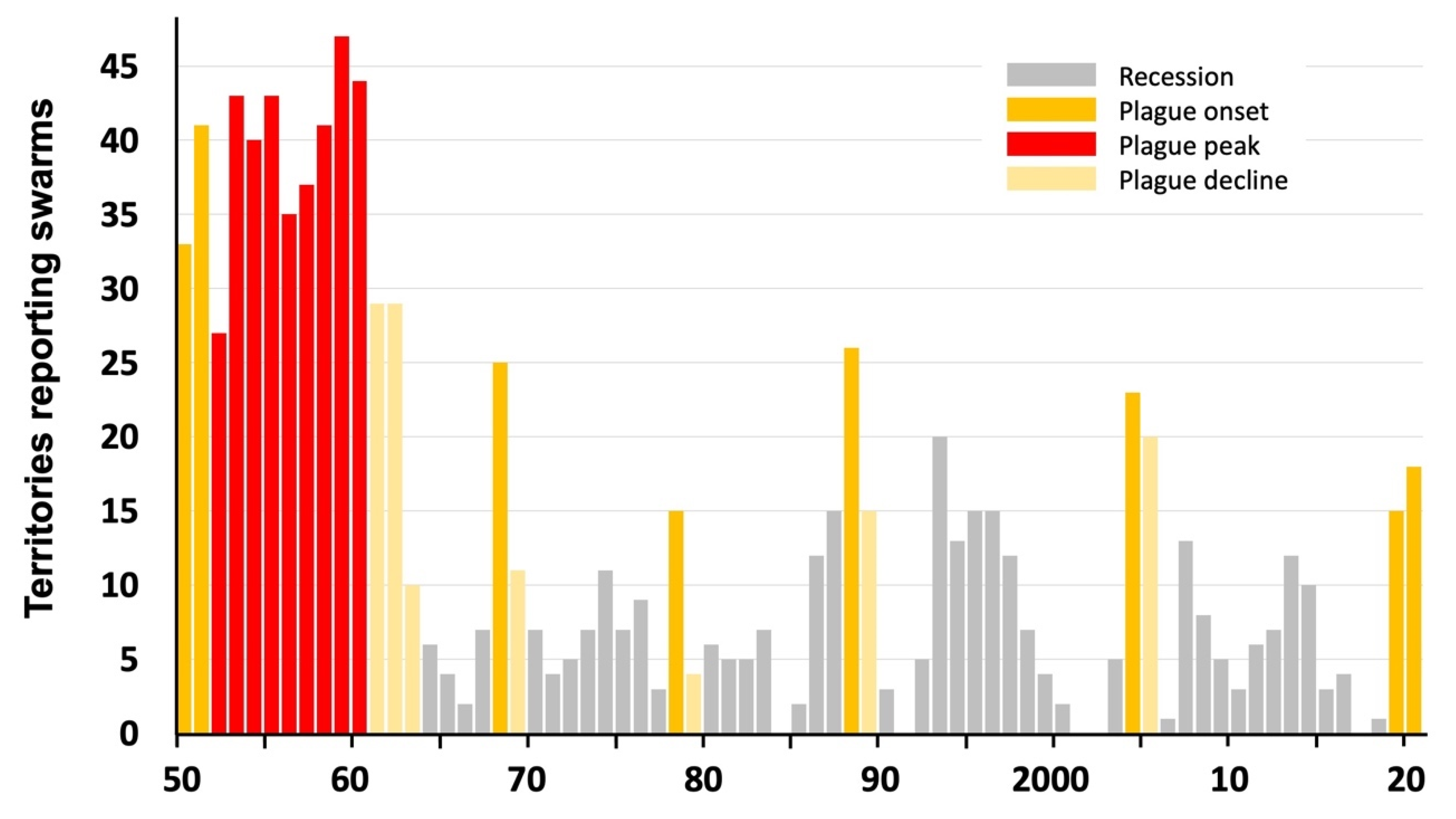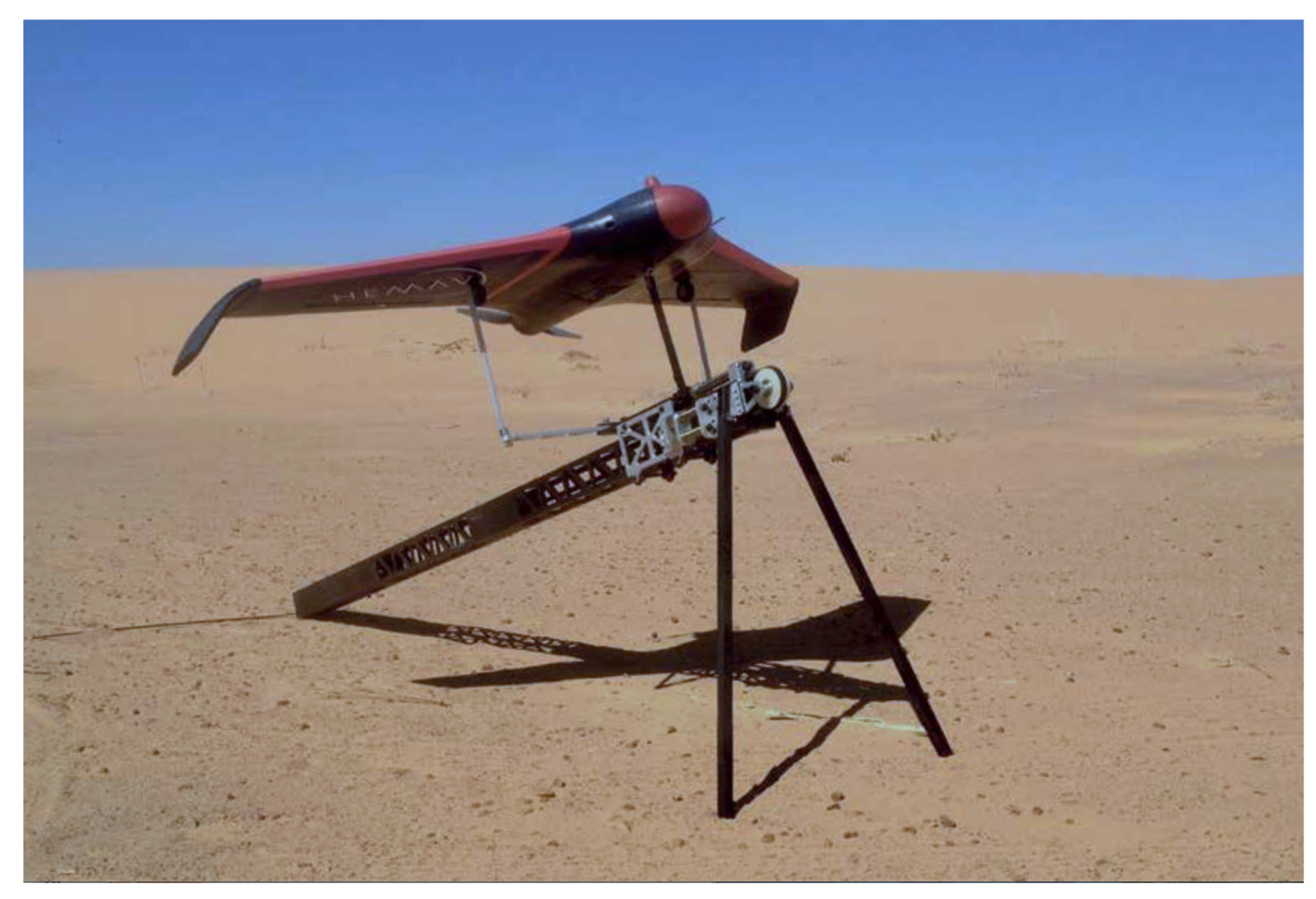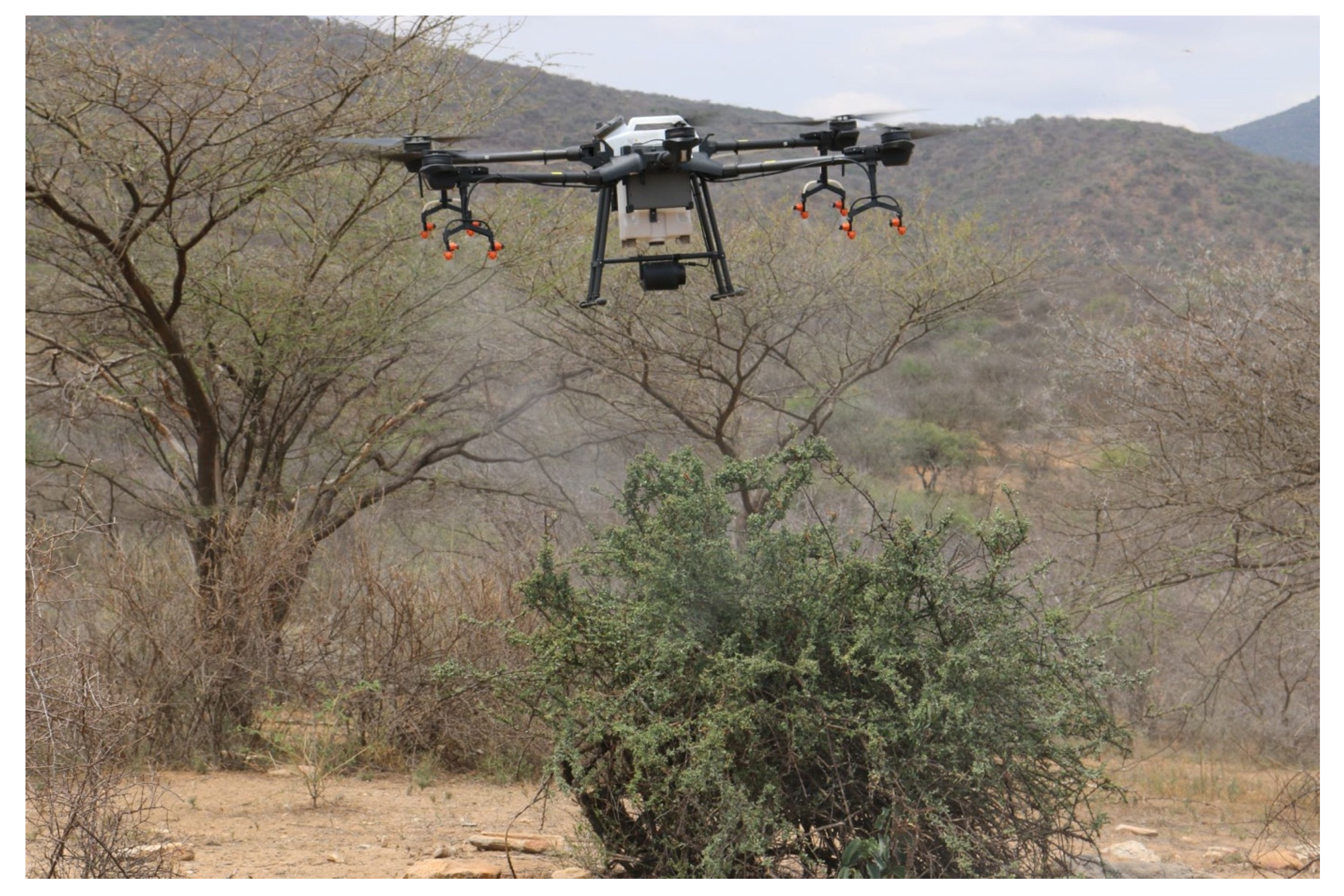New Technology for Desert Locust Control
Abstract
1. Introduction
2. The Initial Signs of a New Upsurge
3. Detecting Where the Locusts Can Be Found after a Recession Period
4. Applying the Biopesticide in Remote Areas at the Initial Stage of Hopper Development
5. Current Trials
5.1. Kenya
5.2. India
- (a)
- The small multi-copter drones do not have an adequate lifting and endurance capacity to treat more than a small area;
- (b)
- Most have hydraulic pressure nozzles that spray too high a volume so the area that can be treated is very limited. The power requirement to pump the volume of water would be better deployed by using ULV sprays applied with a rotary atomiser;
- (c)
- Even when applying a ULV spray with rotary atomisers, the small payload (10–15 kg) carried by drones limits the area that can be treated with significantly higher operating costs than existing ground sprayers. Spraying small areas of trees on which locusts can be resting is one example as the target is not easily accessible with ground equipment;
- (d)
- Most commercial drones are not designed for ULV products, as pumps, hoses and plastic materials are not compatible with the formulations being used;
- (e)
- There is a question over durability in desert environments with sand and dust drawn across exposed electric motors from multi-rotor types;
- (f)
- Battery cost and operating costs are high with limited duty cycle—400 × before they need to be changed;
- (g)
- A larger payload drone (100 kg+) may offer better potential to fill the gap between using ground equipment and manned aircraft.
6. Conclusions
Funding
Acknowledgments
Conflicts of Interest
References
- Bennett, L.V.; Symmons, P.M. A Review of Estimates of the Effectiveness of Certain Control Techniques and Insecticides against the Desert Locust; Anti-locust bulletin 50; Centre for Overseas Pest Research: London, UK, 1972. [Google Scholar]
- FAO. Report of the Meeting on the Use and Hazards of Dieldrin in Desert Locust Control, 19–20 October 1988; FAO: Rome, Italy, 1988. [Google Scholar]
- Lomer, C.J.; Bateman, R.P.; Johnson, D.L.; Langewald, J.; Thomas, M. Biological Control of Locusts and Grasshoppers. Annu. Rev. Entomol. 2001, 46, 667–702. [Google Scholar] [CrossRef]
- FAO. Evaluation of Field Trial Data on the Efficacy and Selectivity of Insecticides on Locusts and Grasshoppers. In Proceedings of the Report to FAO by the Pesticide Referee Group, Seventh Meeting, Rome, Italy, 2–6 March 1998; FAO: Rome, Italy, 1998. Available online: http://www.fao.org/ag/locusts/common/ecg/1154/en/PRG7e.pdf (accessed on 27 March 2021).
- Waloff, Z. Some Temporal Characteristics of Desert Locust Plagues; Anti-Locust Memoir No.1; Anti-Locust Research Centre: London, UK, 1976. [Google Scholar]
- Cressman, K.; Stefanski, R. Weather and Desert Locusts; Technical Report WMO-No. 1175; World Meteorological Organization and Food and Agriculture Organization of the United Nations: Geneva, Switzerland, 2016. [Google Scholar]
- Tratalos, J.A.; Cheke, R.A.; Healey, R.G.; Stenseth, N.C. Desert locust populations, rainfall and climate change: Insights from phenomenological models using gridded monthly data. Clim. Res. 2010, 43, 229–239. [Google Scholar] [CrossRef]
- Latchininsky, A.V. Locusts and remote sensing: A review. J. Appl. Remote Sens. 2013, 7, 075099. [Google Scholar] [CrossRef]
- Cullen, D.A.; Cease, A.J.; Latchininsky, A.V.; Ayali, A.; Berry, K.; Buhl, J.; De Keyser, R.; Foquet, B.; Hadrich, J.C.; Matheson, T.; et al. From molecules to management: Mechanisms and consequences of locust phase polyphenism. Adv. Insect Phys. 2017, 53, 167–285. [Google Scholar]
- Ayali, A. The puzzle of locust density-dependent phase polyphenism. Curr. Opin. Insect Sci. 2019, 35, 41–47. [Google Scholar] [CrossRef]
- Guo, X.; Yu, Q.; Chen, D.; Wei, J.; Yang, P.; Yu, J.; Wang, X.; Kang, L. 4-Vinylanisole is an aggregation pheromone in locusts. Nature 2020, 584, 584–588. [Google Scholar] [CrossRef]
- Vosshall, L.B. Catching plague locusts with their own scent. Nature 2020, 584, 528–530. [Google Scholar] [CrossRef]
- Tratalos, J.A.; Cheke, R.A. Can NDVI GAC imagery be used to monitor desert locust breeding areas? J. Arid Environ. 2006, 64, 342–356. [Google Scholar] [CrossRef]
- Cressman, K. Satellites and GIS in desert locust monitoring worldwide: Lessons learned. In Proceedings of the 7th International IPM Symposium, Memphis, TN, USA, 27–29 March 2012. [Google Scholar]
- Magor, J.I.; Lecoq, M.; Hunter, D.M. Preventive control and Desert Locust plagues. Crop Prot. 2008, 27, 1527–1533. [Google Scholar] [CrossRef]
- Babah, M.A.O.; Sword, G.A. Linking locust gregarization to local resource distribution patterns across a large spatial scale. Environ. Entomol. 2004, 33, 1577–1583. [Google Scholar] [CrossRef]
- Klein, I.; Oppelt, N.; Kuenzer, C. Application of Remote Sensing Data for Locust Research and Management—A Review. Insects 2021, 12, 233. [Google Scholar] [CrossRef]
- Panday, U.S.; Pratihast, A.K.; Aryal, J.; Kayastha, R.B. A Review on Drone-Based Data Solutions for Cereal Crops. Drones 2020, 4, 41. [Google Scholar] [CrossRef]
- Piou, C.; Jaavar Bacar, M.E.H.; Ould Babah Ebbe, M.A.; Chihrane, J.; Ghaout, S.; Cisse, S.; Lecoq, M.; Ben Halima, T. Mapping the spatiotemporal distributions of the Desert Locust in Mauritania and Morocco to improve preventive management. Basic Appl. Ecol. 2017, 25, 37–47. [Google Scholar] [CrossRef]
- Piou, C.; Gay, P.E.; Benahi, A.S.; Babah Ebbe, M.A.O.; Chihrane, J.; Ghaout, S.; Cisse, S.; Diakite, F.; Lazar, M.; Cressman, K.; et al. Soil moisture from remote sensing to forecast desert locust presence. J. Appl. Ecol. 2019, 56, 966–975. [Google Scholar] [CrossRef]
- Drones for Desert Locust Project—Hemav. Available online: https://www.youtube.com/watch?v=QmCznC6CbbE (accessed on 27 March 2021).
- Cressman, K. The Use of New Technologies in Desert Locust Early Warning. Outlooks Pest Manag. 2008, 19, 55–59. [Google Scholar] [CrossRef]
- FAO. eLocust3: Updated Field Data Entry & Transmission. Available online: http://www.fao.org/ag/locusts/en/activ/DLIS/eL3/index.html (accessed on 30 March 2021).
- FAO. Drones for Locust Early Warning & Preventive Control. Available online: http://www.fao.org/ag/locusts/en/activ/DLIS/drones/index.html (accessed on 27 March 2021).
- Langewald, J.; Kooyman, C.; Douro-Kpindou, O.-K.; Lomer, C.J.; Dahmoud, A.O.; Mohammed, H.O. Field treatment of Desert Locust (Schistocerca gregaria Forskål) hoppers in the field in Mauritania with an oil formulation of the entomopathogenic fungus Metarhizium flavoviride. Biocontrol Sci. Technol. 1997, 7, 603–611. [Google Scholar] [CrossRef]
- Lomer, C.J.; Prior, C.; Kooyman, C. Development of Metarhizium spp. for the control of grasshoppers and locusts. Mem. Entomol. Soc. Can. 1997, 171, 265–286. [Google Scholar] [CrossRef]
- Moore, D.; Caudwell, R.W. Formulation of entomopathogens for the control of grasshoppers and locusts. Mem. Entomol. Soc. Can. 1997, 171, 49–67. [Google Scholar] [CrossRef]
- Bateman, R.P.; Carey, M.; Moore, D.; Prior, C. The enhanced infectivity of Metarhizium flavoviride in oil formulations to desert locusts at low humidities. Ann. Appl. Biol. 1993, 122, 145–152. [Google Scholar] [CrossRef]
- Price, R.E.; Bateman, R.P.; Brown, H.D.; Butler, E.T.; Müller, E.J. Aerial spray trials against brown locust (Locustana pardalina, Walker) nymphs in South Africa using oil-based formulations of Metarhizium flavoviride. Crop Prot. 1997, 16, 345–351. [Google Scholar] [CrossRef]
- Bateman, R.P. Methods of application of microbial pesticide formulations for the control of locusts and grasshoppers. Mem. Entomol. Soc. Can. 1997, 171, 69–81. [Google Scholar] [CrossRef]
- Hunter, D.M. Credibility of an IPM Approach for Locust and Grasshopper Control: The Australian Example. J. Orthoptera Res. 2010, 19, 133–137. [Google Scholar] [CrossRef][Green Version]
- Mullié, W.C.; Cheke, R.A.; Young, S.; Ibrahim, A.B.; Murk, A.J. Increased and sex-selective avian predation of desert locusts Schistocerca gregaria treated with Metarhizium acridum. PLoS ONE 2021, 16, e0244733. [Google Scholar] [CrossRef] [PubMed]
- CABI. Drones for Desert Locust Control in East Africa. Available online: https://www.cabi.org/projects/drones-for-desert-locust-control-in-east-africa/ (accessed on 27 March 2021).
- Johnstone, D.R. Variations in insecticide dose received by settled locusts: A computer model for ultra-low volume Spraying. Crop Prot. 1991, 11, 183–194. [Google Scholar] [CrossRef]
- Kumar, K.S.; Abdul Rahman, A. Early Detection of Locust Swarms Using Deep Learning. In Advances in Machine Learning and Computational Intelligence; Patnaik, S., Yang, X.S., Sethi, I., Eds.; Springer: Singapore, 2021; pp. 303–310. [Google Scholar] [CrossRef]
- Showler, A.T.; Lecoq, M. Incidence and Ramifications of Armed Conflict in Countries with Major Desert Locust Breeding Areas. Agronomy 2021, 11, 114. [Google Scholar] [CrossRef]
Short Biography of Author



Publisher’s Note: MDPI stays neutral with regard to jurisdictional claims in published maps and institutional affiliations. |
© 2021 by the author. Licensee MDPI, Basel, Switzerland. This article is an open access article distributed under the terms and conditions of the Creative Commons Attribution (CC BY) license (https://creativecommons.org/licenses/by/4.0/).
Share and Cite
Matthews, G.A. New Technology for Desert Locust Control. Agronomy 2021, 11, 1052. https://doi.org/10.3390/agronomy11061052
Matthews GA. New Technology for Desert Locust Control. Agronomy. 2021; 11(6):1052. https://doi.org/10.3390/agronomy11061052
Chicago/Turabian StyleMatthews, Graham A. 2021. "New Technology for Desert Locust Control" Agronomy 11, no. 6: 1052. https://doi.org/10.3390/agronomy11061052
APA StyleMatthews, G. A. (2021). New Technology for Desert Locust Control. Agronomy, 11(6), 1052. https://doi.org/10.3390/agronomy11061052




